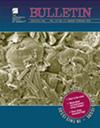地质历史中制约水流和泥沙输送的间歇性
IF 3.9
1区 地球科学
Q1 GEOSCIENCES, MULTIDISCIPLINARY
引用次数: 1
摘要
对古代河流的定量调查通常提供对瞬时或平均流量条件的见解。这些调查时间尺度之间存在一个关键的差距,这反映了水流和泥沙运输的间歇性,缩小这一差距对于充分探索古代河流景观的动力学和演化至关重要。在此,我们将河流地层数据集、水流和泥沙运输模型以及古气候环流模型(GCM)的结果结合起来,开发了新的方法来估计地质过去的间歇性,特别是水流间歇因子(Iw)和泥沙运输间歇因子(Is),并展示了如何使用它们来探索过去的水道形状。我们用美国西部犹他州的上白垩纪最后一次机会铁砂岩来说明这些方法。对于Last Chance Ferron河流的输沙流条件,我们估计Iw值为0.54 ~ 0.90,这意味着河道形成条件持续了一年的大部分时间,与持续了相对较大的流量的多年生系统一致。相比之下,对于砂石输送流条件,Iw值为0.28 ~ 0.38表明,最大的形成流可能占据了Last Chance Ferron河流近三分之一的时间,这可以解释为季风系统中持续发生高强度流量事件,或者亚热带系统中高强度流量事件持续时间短但频率高。同时,Is值为0.075 ~ 0.15表明,如果河道形成条件持续,年泥沙收支可能在短至10天,长至2个月的时间内进行输送,这些值突出表明,河道形成条件持续时间的微小变化可能会显著影响泥沙收支。我们的结果与对Last Chance Ferron河流的独立相和代理的见解是一致的,这些见解指向一个以季风或亚热带排放制度为特征的长期潮湿系统。此外,我们的结果强调了利用古气候gcm来约束地质过去的间歇性因子的新机会。展望未来,在岩石记录不完整或难以获取,或地层方法有限的地方,古气候gcm将特别有用,它们将使我们能够解决有关地球和其他行星过去表面过程的相关研究问题。本文章由计算机程序翻译,如有差异,请以英文原文为准。
Constraining flow and sediment transport intermittency in the geological past
Quantitative investigations of ancient rivers usually provide insights into either instantaneous or mean flow conditions. There is a critical gap between these time scales of investigation, which reflects the intermittency of flow and sediment transport, and closing this gap is crucial to fully explore the dynamics and evolution of ancient fluvial landscapes. Here, we combined fluvial stratigraphic data sets, flow and sediment transport models, and paleoclimate general circulation model (GCM) results to develop new methods to estimate intermittency in the geological past, specifically flow intermittency factors (Iw) and sediment transport intermittency factors (Is), and we show how they can be used to explore past hydrograph shapes. We illustrated these methods using the Upper Cretaceous Last Chance Ferron Sandstone in Utah, western United States. For sand-transporting flow conditions in Last Chance Ferron rivers, we estimated Iw values of 0.54−0.90, which imply that channel-forming conditions were sustained for the majority of the year, consistent with perennial systems in which relatively large discharges were sustained. In contrast, for gravel-transporting flow conditions, Iw values of 0.28−0.38 suggest that the largest formative flows may have occupied Last Chance Ferron rivers for nearly a third of the year, which could be explained by a monsoonal system in which high-magnitude discharge events were sustained, or a subtropical system in which high-magnitude discharge events had short durations but high frequencies. Meanwhile, Is values of 0.075−0.15 suggest that annual sediment budgets could have been transported in as little as 10 days and up to 2 months, if channel-forming conditions were sustained, and these values highlight that small changes in the duration of channel-forming conditions could significantly impact sediment budgets. Our results are consistent with independent facies- and proxy-based insights into Last Chance Ferron rivers, which point to a perennially wet system characterized by a monsoonal or subtropical discharge regime. Further, our results highlight new opportunities to use paleoclimate GCMs to constrain intermittency factors in the geological past. Going forward, paleoclimate GCMs will be particularly useful where the rock record is incomplete or inaccessible, or where stratigraphic approaches are limited, and they will enable us to tackle pertinent research questions pertaining to past surface processes on both Earth and other planets.
求助全文
通过发布文献求助,成功后即可免费获取论文全文。
去求助
来源期刊

Geological Society of America Bulletin
地学-地球科学综合
CiteScore
9.30
自引率
8.20%
发文量
159
审稿时长
4-8 weeks
期刊介绍:
The GSA Bulletin is the Society''s premier scholarly journal, published continuously since 1890. Its first editor was William John (WJ) McGee, who was responsible for establishing much of its original style and format. Fully refereed, each bimonthly issue includes 16-20 papers focusing on the most definitive, timely, and classic-style research in all earth-science disciplines. The Bulletin welcomes most contributions that are data-rich, mature studies of broad interest (i.e., of interest to more than one sub-discipline of earth science) and of lasting, archival quality. These include (but are not limited to) studies related to tectonics, structural geology, geochemistry, geophysics, hydrogeology, marine geology, paleoclimatology, planetary geology, quaternary geology/geomorphology, sedimentary geology, stratigraphy, and volcanology. The journal is committed to further developing both the scope of its content and its international profile so that it publishes the most current earth science research that will be of wide interest to geoscientists.
 求助内容:
求助内容: 应助结果提醒方式:
应助结果提醒方式:


